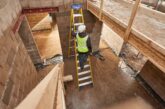
Most builders get very little time to recharge and review their equipment, even though taking the time to look over your valuable tools can increase their lifespan and make sure you’re safer on the job.
So, despite the many challenges that this period of downtime has brought to the construction industry, it has also provided an opportune time to check over tools that might have been lingering in the back of your van to make sure you’re on the front foot as work begins to pick up.
As a starting point, take a look at the checklist from Werner below, which covers some of the key components you need to check when performing a ladder inspection:
- Feet tips and end caps
It’s important that feet tips are all present and secure, and you ensure rivets and other fixings are present, too. The feet shouldn’t be warped in any way and the anti-slip ground contact surfaces should be undamaged and clear of dirt or other debris. Stile ends should be undamaged and there should be no cracks, cuts or holes.
- Braces and cross tubes
While some wear and tear is ok, anything bending, bowing, folding or creasing that is pronounced or excessive needs to be fixed straight away. Additionally, there should be no twisting. Likewise, rivets and other fixings should all be present and secure and rust or corrosion should be kept to a level where it doesn’t damage any of the ladder’s structure.
- Platforms
When it comes to stepladders, it’s important to ensure the platform is in a safe condition. As we’ve mentioned previously, make sure all fittings are present and undamaged, and the platform is free of any bending on the upper surface as well as any folding or twisting. There should also be no significant denting that might compromise the strength of the platform and the support and linkage mechanism are both present and undamaged.
- Rungs and treads
Of course, all rungs should be present, and there should not be any bending, bowing or twisting. If there is any significant denting that might compromise the strength of the tread, the ladder should be replaced. To minimise the risk of slips whilst climbing the ladder, make sure the ladder is clean and free from spillages like paint and plaster.
- Stiles and frames
Much like with the rest of the ladder, the stiles and frames should be checked to ensure there is no bending, longitudinal twisting or bowing, and that it is generally rigid. The front to rear frame attachment or hinging should be secure and and other rivets and fixings should be present. There should be no signs of corrosion to components and they should be clean of dirt, paint, oil or grease. All stops/bushes and other safety restraint devices present, secure and undamaged, along with any stabilisers where required.
In addition to these steps, relevant checks should also be carried out on the locking catches, rung hooks, restraint devices and guide brackets to ensure they are all working correctly and aren’t displaying any signs of damage.







